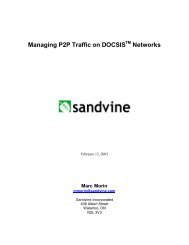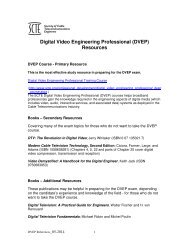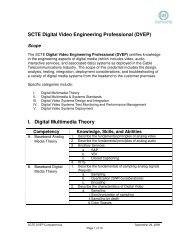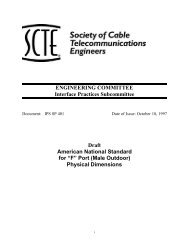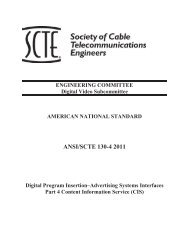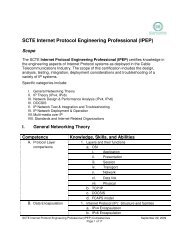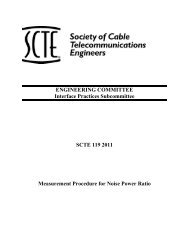ANSI/SCTE 16 2001R2007
ANSI/SCTE 16 2001R2007
ANSI/SCTE 16 2001R2007
You also want an ePaper? Increase the reach of your titles
YUMPU automatically turns print PDFs into web optimized ePapers that Google loves.
Appendix 3 – Conversion of Hum Modulation from dB to percent (%)<br />
The Federal Communications Commission (FCC) defines hum in Technical Standards part<br />
76.605(a) as: The peak to peak variation in visual signal level caused by undesired low<br />
frequency disturbances (hum or repetitive transients) generated within the system, or by<br />
inadequate low frequency response, shall not exceed 3 percent of the visual signal level.<br />
This appendix will detail the derivation of hum modulation in percent, and will provide a table<br />
with conversions of hum modulation from mV p-p to dB and percent hum.<br />
Hum Modulation may be expressed as a percentage of the peak to peak variation of the carrier<br />
level to the peak voltage amplitude of the carrier. From equations A-9 and A-10, located in<br />
Appendix 2, Env max is defined as the –1 dB delta in B (envelope change) that can be compared to<br />
the actual peak to peak hum voltage (Env max - Env min , or Hum p-p ) to give a hum modulation ratio.<br />
To express hum modulation as a percent:<br />
Hum(%)<br />
⎛ HummVp−p<br />
⎞ ⎛ HummVp−p<br />
⎞<br />
= ⎜ ⎟ *100% ⎜<br />
⎟<br />
*100% = .109* HummVp−p<br />
Env<br />
=<br />
(A-13)<br />
max<br />
919.5mV<br />
⎝ ⎠ ⎝<br />
p−p<br />
⎠<br />
where,<br />
Env<br />
max<br />
100mV 100mV<br />
= (from A-9)<br />
p−p<br />
p−p<br />
( 20)<br />
p p<br />
[ ] 1/ = = 919.5mV<br />
−<br />
−<br />
1−10<br />
.1087<br />
The 100mV delta is shown as the standard reference. However, for hum measurements, the<br />
actual delta of voltages between the 1 dB change should be used for improved accuracy.<br />
The conversion of hum in mV p-p to dB and percent is shown in Table 1.<br />
13





